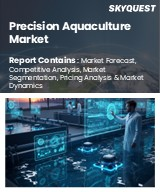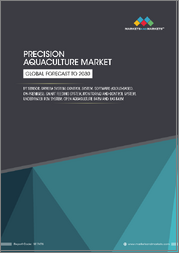
|
시장보고서
상품코드
1568635
세계의 정밀 양식 시장 : 기회, 성장 촉진요인, 산업 동향 분석 및 예측(2024-2032년)Precision Aquaculture Market, Opportunity, Growth Drivers, Industry Trend Analysis and Forecast, 2024-2032 |
||||||
세계 정밀 양식 시장은 양식업의 모니터링 및 관리 역량을 강화하는 기술 혁신으로 인해 2024년부터 2032년까지 15%의 연평균 복합 성장률(CAGR)을 보일 것으로 예상됩니다.
이러한 기술 혁신은 실시간 데이터 수집 및 분석을 통해 환경 조건, 사료 관리 및 건강 모니터링을 보다 정밀하게 제어할 수 있게 해줍니다. 예를 들어, 아쿠아바이트는 2024년 6월, 매일 100만 장 이상의 이미지를 촬영하는 수중 카메라가 장착된 송어용 데이터 기반 모니터링 시스템을 발표했으며, AI와 머신러닝을 통해 송어 생산에 특화된 이 수, 물고기 복지, 바이오매스 등 최신 정보를 제공합니다.
또한, 세계 인구 증가와 건강 지향적인 소비자들의 수산물 수요 증가는 지속 가능하고 효율적인 양식업에 대한 투자를 촉진하고 시장 확대에 박차를 가하고 있습니다.
정밀 양식 산업은 제공, 양식장 유형, 시스템 유형, 용도, 지역별로 분류됩니다.
소프트웨어 분야는 고급 데이터 분석 및 의사결정 지원 시스템에 대한 수요 증가로 인해 조사 기간 동안 견조한 성장세를 기록할 것으로 보입니다. 양식업의 규모가 확대되고 복잡해짐에 따라 종합적인 데이터 통합, 예측 분석, 자동 보고를 제공하는 소프트웨어 솔루션이 필수적입니다. 이러한 도구는 실용적인 통찰력을 제공하고 보다 정확한 관리 방법을 촉진하여 운영자가 성과를 최적화하고 자원을 효율적으로 관리하며 지속가능성을 향상시킬 수 있도록 돕습니다. 양식업에서 데이터 기반 접근 방식으로의 전환은 소프트웨어 제품의 성장을 가속하고 있습니다.
RAS 분야는 보다 지속 가능하고 효율적인 양식을 촉진하고 2032년까지 상당한 정밀 양식 시장 점유율을 차지할 것으로 예상되며, RAS 양식장은 물을 재사용하고 최적의 상태를 유지하는 능력으로 잘 알려져 있으며, 환경적 이점과 외부 수자원에 대한 의존도를 낮추는 것으로 인해 점점 더 많이 채택되고 있습니다. 채택되고 있습니다. 이 양식장은 생태계에 미치는 영향을 최소화하고 자원 관리를 개선하기 위해 시스템 성능과 모니터링 능력을 향상시키는 고급 정밀 양식 솔루션에 대한 수요가 증가하고 있으며, RAS 기술이 발전함에 따라 정밀 방법의 채택이 촉진되어 시장 성장을 지원하고 있습니다.
북미 정밀 양식 시장은 2032년까지 낙관적인 성장세를 보일 것으로 전망되며, 기술 발전과 지원적인 규제 프레임워크에 힘입어 성장세를 이어갈 것으로 보입니다. 연구개발에 대한 투자 증가는 양식 기술 혁신을 촉진하고 보다 효율적이고 지속 가능한 양식 방법을 가져오고 있습니다. 또한, 지속 가능한 수산물 생산과 환경 보전을 촉진하기 위한 정부의 이니셔티브와 재정적 지원은 시장 성장을 가속하고 있습니다. 고품질, 추적 가능한 수산물에 대한 소비자의 선호도가 높아지고 식량 안보 강화에 대한 관심이 높아지면서 정밀 양식 솔루션에 대한 수요를 더욱 자극하고 있습니다.
목차
제1장 조사 방법과 조사 범위
제2장 주요 요약
제3장 업계 인사이트
- 생태계 분석
- 공급업체 상황
- 기술 제공업체
- 서비스 제공업체
- 시스템 통합사업자-
- 유통·물류
- 최종사용자
- 이익률 분석
- 기술 혁신 상황
- 특허 분석
- 주요 뉴스와 이니셔티브
- 규제 상황
- 영향요인
- 성장 촉진요인
- 업계의 잠재적 리스크&과제
- 성장 가능성 분석
- Porter's Five Forces 분석
- PESTEL 분석
제4장 경쟁 구도
- 서론
- 기업 점유율 분석
- 경쟁 포지셔닝 매트릭스
- 전략 전망 매트릭스
제5장 시장 추산·예측 : 제공 제품별, 2021년-2032년
- 주요 동향
- 하드웨어
- 센서
- 모니터링 기기
- 급이 장비
- 수중 카메라
- 소프트웨어
- 데이터 분석 플랫폼
- 농장 관리 소프트웨어
- 서비스
- 설치 및 메인터넌스
- 컨설팅 및 트레이닝
제6장 시장 추산·예측 : 농장 유형별, 2021년-2032년
- 주요 동향
- 개방형 양식
- RAS 양식
제7장 시장 추산·예측 : 시스템 유형별, 2021년-2032년
- 주요 동향
- 스마트 급이
- 모니터링 및 제어
- 수중 ROV
- 기타
제8장 시장 추산·예측 : 용도별, 2021년-2032년
- 주요 동향
- 사료 최적화
- 모니터링 및 감시
- 수량 분석 및 측정
- 기타
제9장 시장 추산·예측 : 지역별, 2021년-2032년
- 주요 동향
- 북미
- 미국
- 캐나다
- 유럽
- 영국
- 독일
- 프랑스
- 스페인
- 이탈리아
- 러시아
- 북유럽
- 기타 유럽
- 아시아태평양
- 중국
- 인도
- 일본
- 한국
- 뉴질랜드
- 동남아시아
- 기타 아시아태평양
- 라틴아메리카
- 브라질
- 멕시코
- 아르헨티나
- 기타 라틴아메리카
- 중동 및 아프리카
- 아랍에미리트(UAE)
- 남아프리카공화국
- 사우디아라비아
- 기타 중동 및 아프리카
제10장 기업 개요
- AKVA Group
- Aquabyte
- Aquaculture Systems Technologies, LLC(AST)
- Aqualine AS
- AquaMaof Aquaculture Technologies Ltd.
- Bluegrove
- CageEye
- Eruvaka Technologies
- Innovasea
- OxyGuard International A/S
- Pentair Aquatic Eco-Systems, Inc.
- Realtime Aquaculture
- ScaleAQ
- Steinsvik Group AS
- Umitron
- VAKI Aquaculture Systems Ltd.
- Veolia Water Technologies
- XpertSea
- Xylem Inc.
- Yara International
The Global Precision Aquaculture Market will exhibit a 15% CAGR from 2024 to 2032, driven by innovations in technology enhancing monitoring and management capabilities in aquaculture. These innovations enable real-time data collection and analysis, leading to more precise control over environmental conditions, feed management, and health monitoring. For instance, in June 2024, Aquabyte launched a data-driven monitoring system for trout, featuring submerged cameras that capture over a million images daily. Using AI and machine learning, it provides updates on lice counts, fish welfare, and biomass, tailored specifically for trout production.
Additionally, increasing demand for seafood due to rising global populations and health-conscious consumers is encouraging investments in sustainable and efficient aquaculture practices, fueling market expansion.
The precision aquaculture industry is categorized based on offering, farm type, system type, application, and region.
The software segment will record a robust growth pace over the study period, due to the increasing need for advanced data analytics and decision-support systems. As aquaculture operations scale and become more complex, software solutions that provide comprehensive data integration, predictive analytics, and automated reporting are becoming essential. These tools help operators optimize performance, manage resources efficiently, and improve sustainability by providing actionable insights and facilitating more precise management practices. The shift towards data-driven approaches in aquaculture is driving the growth of software offerings, as they are crucial for enhancing operational efficiency and achieving better outcomes.
The RAS segment will account for a substantial precision aquaculture market share by 2032, promoting more sustainable and efficient fish farming practices. RAS farms, known for their ability to recycle water and maintain optimal conditions, are increasingly adopted due to their environmental benefits and reduced dependency on external water sources. This farm minimizes ecological impact and improves resource management, which drives the demand for advanced precision aquaculture solutions that enhance system performance and monitoring capabilities. As RAS technology advances, it fosters greater adoption of precision methods, supporting market growth.
North America precision aquaculture market will show optimistic growth trends through 2032, bolstered by technological advancements and supportive regulatory frameworks. Increased investment in R and D is fostering innovation in aquaculture technologies, leading to more efficient and sustainable farming practices. Additionally, government initiatives and funding aimed at promoting sustainable seafood production and environmental conservation are bolstering market growth. The rising consumer preference for high-quality, traceable seafood and strong focus on enhancing food security further stimulate demand for precision aquaculture solutions.
Table of Contents
Chapter 1 Methodology and Scope
- 1.1 Research design
- 1.1.1 Research approach
- 1.1.2 Data collection methods
- 1.2 Base estimates and calculations
- 1.2.1 Base year calculation
- 1.2.2 Key trends for market estimates
- 1.3 Forecast model
- 1.4 Primary research and validation
- 1.4.1 Primary sources
- 1.4.2 Data mining sources
- 1.5 Market definitions
Chapter 2 Executive Summary
- 2.1 Industry 360° synopsis, 2021 - 2032
Chapter 3 Industry Insights
- 3.1 Industry ecosystem analysis
- 3.2 Supplier landscape
- 3.2.1 Technology provider
- 3.2.2 Service provider
- 3.2.3 System integrators
- 3.2.4 Distribution and logistics
- 3.2.5 End user
- 3.3 Profit margin analysis
- 3.4 Technology and innovation landscape
- 3.5 Patent analysis
- 3.6 Key news and initiatives
- 3.7 Regulatory landscape
- 3.8 Impact forces
- 3.8.1 Growth drivers
- 3.8.1.1 Technological advancements in aquaculture monitoring and control systems.
- 3.8.1.2 Increasing adoption of IoT and AI technologies.
- 3.8.1.3 Rising demand for sustainable aquaculture practices globally.
- 3.8.1.4 Government initiatives supporting aquaculture innovation and investment.
- 3.8.2 Industry pitfalls and challenges
- 3.8.2.1 High initial costs for advanced technology implementation.
- 3.8.2.2 Limited skilled workforce for technology management.
- 3.8.1 Growth drivers
- 3.9 Growth potential analysis
- 3.10 Porter's analysis
- 3.11 PESTEL analysis
Chapter 4 Competitive Landscape, 2023
- 4.1 Introduction
- 4.2 Company market share analysis
- 4.3 Competitive positioning matrix
- 4.4 Strategic outlook matrix
Chapter 5 Market Estimates and Forecast, By Offering, 2021 - 2032 ($Bn)
- 5.1 Key trends
- 5.2 Hardware
- 5.2.1 Sensors
- 5.2.2 Monitoring devices
- 5.2.3 Feeding devices
- 5.2.4 Underwater cameras
- 5.3 Software
- 5.3.1 Data analytics platforms
- 5.3.2 Farm management software
- 5.4 Services
- 5.4.1 Installation and maintenance
- 5.4.2 Consulting and training
Chapter 6 Market Estimates and Forecast, By Farm Type, 2021 - 2032 ($Bn)
- 6.1 Key trends
- 6.2 Open aquaculture
- 6.3 RAS
Chapter 7 Market Estimates and Forecast, By System Type, 2021 - 2032 ($Bn)
- 7.1 Key trends
- 7.2 Smart feeding
- 7.3 Monitoring and control
- 7.4 Underwater ROVs
- 7.5 Others
Chapter 8 Market Estimates and Forecast, By Application, 2021 - 2032 ($Bn)
- 8.1 Key trends
- 8.2 Feed optimization
- 8.3 Monitoring and surveillance
- 8.4 Yield analysis and measurement
- 8.5 Others
Chapter 9 Market Estimates and Forecast, By Region, 2021 - 2032 ($Bn)
- 9.1 Key trends
- 9.2 North America
- 9.2.1 U.S.
- 9.2.2 Canada
- 9.3 Europe
- 9.3.1 UK
- 9.3.2 Germany
- 9.3.3 France
- 9.3.4 Spain
- 9.3.5 Italy
- 9.3.6 Russia
- 9.3.7 Nordics
- 9.3.8 Rest of Europe
- 9.4 Asia Pacific
- 9.4.1 China
- 9.4.2 India
- 9.4.3 Japan
- 9.4.4 South Korea
- 9.4.5 ANZ
- 9.4.6 Southeast Asia
- 9.4.7 Rest of Asia Pacific
- 9.5 Latin America
- 9.5.1 Brazil
- 9.5.2 Mexico
- 9.5.3 Argentina
- 9.5.4 Rest of Latin America
- 9.6 MEA
- 9.6.1 UAE
- 9.6.2 South Africa
- 9.6.3 Saudi Arabia
- 9.6.4 Rest of MEA
Chapter 10 Company Profiles
- 10.1 AKVA Group
- 10.2 Aquabyte
- 10.3 Aquaculture Systems Technologies, LLC (AST)
- 10.4 Aqualine AS
- 10.5 AquaMaof Aquaculture Technologies Ltd.
- 10.6 Bluegrove
- 10.7 CageEye
- 10.8 Eruvaka Technologies
- 10.9 Innovasea
- 10.10 OxyGuard International A/S
- 10.11 Pentair Aquatic Eco-Systems, Inc.
- 10.12 Realtime Aquaculture
- 10.13 ScaleAQ
- 10.14 Steinsvik Group AS
- 10.15 Umitron
- 10.16 VAKI Aquaculture Systems Ltd.
- 10.17 Veolia Water Technologies
- 10.18 XpertSea
- 10.19 Xylem Inc.
- 10.20 Yara International













